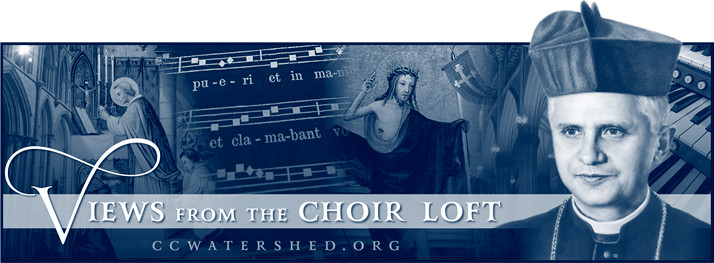 HENEVER I DISCOVER something interesting, I follow the example of Josef Hofmann and jot it down 1 in a designated spot. An example would be how President Ronald Reagan chose someone as his Chief of Staff whose name was almost identical: Donald Regan. Well, today I have something to say which you might want to write down. You probably won’t believe it, but it’s true:
HENEVER I DISCOVER something interesting, I follow the example of Josef Hofmann and jot it down 1 in a designated spot. An example would be how President Ronald Reagan chose someone as his Chief of Staff whose name was almost identical: Donald Regan. Well, today I have something to say which you might want to write down. You probably won’t believe it, but it’s true:
The Nicene Creed does not
say that Our Lord “died”—
the word “death” was added
in the 1970s by ICEL.
Now, it is certainly true that when we pray the Apostle’s Creed (not the Nicene Creed) we find these words:
“passus sub Póntio Piláto, crucifíxus, mórtuus, et sepúltus”
“suffered under Pontius Pilate, was crucified, died and was buried”
But the Nicene Creed says something different, as this 1957 Missal shows, and please pay careful attention the Latin taken directly from the official 1962 Missal:
“Crucifíxus étiam pro nobis:
sub Póntio Piláto passus,
et sepúltus est.”
“He was crucified also for us,
suffered under Pontius Pilate,
and was buried.”
This translation is nothing new, as this 1806 Missal shows. The 1965 Roman Missal says the same thing. But look at the rather strange way ICEL chose to translate this passage in the 1970s—adding “died” and tampering with suffered under Pontius Pilate:
“Crucifíxus étiam pro nobis:
sub Póntio Piláto passus,
et sepúltus est.”
“For our sake he was
crucified under Pontius Pilate;
he suffered, died, and was buried.”
To be fair to ICEL, the official Latin punctuation seems to have been modified in the 1970 version of the ORDO MISSAE—but there is still no mention of “death” (mórtuus). Was such a change justified? Was ICEL afraid that people might think Our Lord was somehow crucified yet did not die? Or was ICEL confused, unwittingly mixing up the Nicene Creed with the Apostle’s Creed? It is true that the Latin word “passio” could refer to the sufferings under Pontius Pilate (e.g. the unjust scourging) and also to our Lord’s death: the culmination of his sufferings. For example, consider the use of “passio,” as in Passio Domini Nostri Jesu Christi. The martyrdom of a saint is also called “passio.”
The revised (“MR3”) ICEL translation published circa 2010 also inexplicably adds the word “death” and thereby seems to downplay (for example) the unjust scourging of Our Lord:
“Crucifíxus étiam pro nobis:
sub Póntio Piláto passus,
et sepúltus est.”
“For our sake he was crucified
under Pontius Pilate; he
suffered death and was buried.”
It would be interesting to see if the word “death” was added in French, German, Italian, or any other language.

Since we are speaking of the “Passio” of Our Lord Jesus Christ, I would like to share some pages from an absolutely remarkable Roman Catholic manuscript:
* (15th century MS.) • “Catherine of Cleves Hours”
—This is the greatest Dutch illuminated manuscript in the world.
![]()
Agony in the Garden • Arrest of Christ
![]()
Our Lord before Caiaphas • Christ is mocked
![]()
Our Lord before Pilate • Christ before Herod
![]()
Our Lord is unjustly scourged • Crowning with thorns
![]()
Carrying of the Cross • Preparation of the Cross
![]()
Our Lord’s Crucifixion • Joseph of Arimathaea before Pilate
![]()
Our Lord is taken down • The Lamentation
![]()
Our Lord is placed in the tomb • The Resurrection
![]()
The Holy Trinity • God the Father
![]()
God the Son
![]()
Three Divine Persons of the Trinity
![]()
Christ Accepts His Father’s Decree to Save Mankind
![]()
The Infant Christ is sent to earth
![]()
Man of Sorrows Returned to the Trinitarian Throne
![]()
The rulers of earth adore the Trinity

NOTES FROM THIS ARTICLE:
1 Josef Hofmann—the greatest pianist of all time—also had an excellent memory. He could hear a complicated piece of music just once and memorize it instantly. In concerts, he would play pieces he hadn’t thought about (much less practiced) for decades—which is why he would bring a copy of the program with him on stage, to find out what he was performing! Josef Hofmann once gave a series of twenty-one consecutive concerts in St. Petersburg without repeating a single piece, playing 255 different works from memory. Yet (according to Abe Chasins) Hofmann kept a little notebook with him at all times, and jotted down things he found particularly interesting so he could remember them.
















